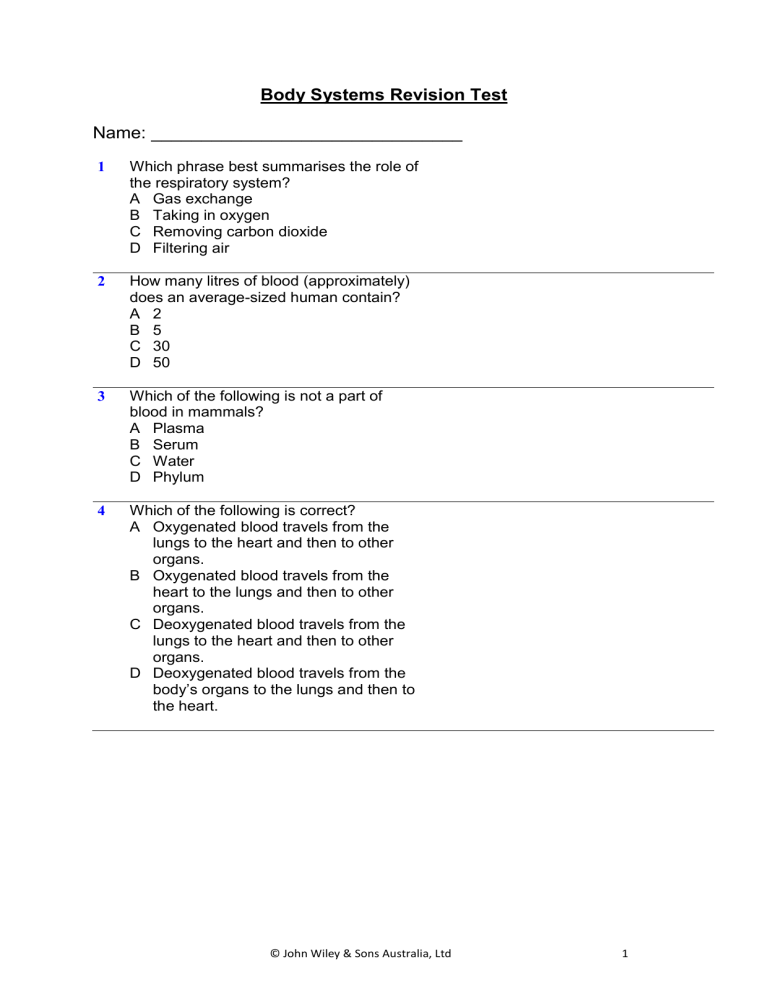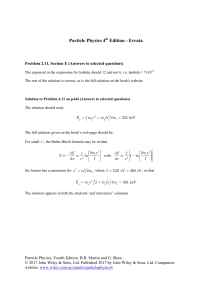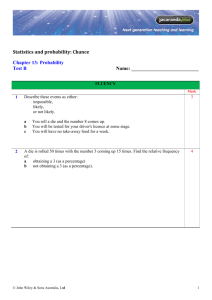
Body Systems Revision Test Name: _______________________________ 1 Which phrase best summarises the role of the respiratory system? A Gas exchange B Taking in oxygen C Removing carbon dioxide D Filtering air 2 How many litres of blood (approximately) does an average-sized human contain? A 2 B 5 C 30 D 50 3 Which of the following is not a part of blood in mammals? A Plasma B Serum C Water D Phylum 4 Which of the following is correct? A Oxygenated blood travels from the lungs to the heart and then to other organs. B Oxygenated blood travels from the heart to the lungs and then to other organs. C Deoxygenated blood travels from the lungs to the heart and then to other organs. D Deoxygenated blood travels from the body’s organs to the lungs and then to the heart. © John Wiley & Sons Australia, Ltd 1 Test 5 Which of the following correctly describes the role of the systems listed? Digestive system A Break up food and absorb nutrients Circulatory Excretory system system Move food Remove cellular through the body wastes B Absorb nutrients Transport dissolved chemicals Remove cellular wastes C Break up food Transport gases Remove dissolved wastes in water and solid wastes D Break up food and absorb nutrients Transport dissolved chemicals and gases Remove dissolved wastes in water and solid wastes 6 Identify the gas we excrete as waste via our lungs. A Oxygen B Helium C Carbon dioxide D Nitrogen 7 The process of using oxygen to release energy from food is called: A breathing. B respiration. C excretion. D oxygenation. 8 The air we breathe out is composed mainly of A oxygen. B carbon dioxide. C water vapour. D nitrogen. 9 The scientific name for windpipe is: A oesophagus. B trachea. C bronchus. D diaphragm. © John Wiley & Sons Australia, Ltd 2 Test 10 Which of the following is not a role of the skeletal system? A Support B Coordination C Movement D Protection 11 Asthma is: A a blockage of air pipes. B another name for reduced lung capacity. C inflammation of the air sacs. D a narrowing of the air pipes. 12 Which one of the following is not caused by smoking? A Increased heart rate B High blood pressure C Increased cholesterol levels D Bad breath 13 Your body uses no energy A when you remain quite still. B only if you stay still and hold your breath. C when you are asleep. D never (while you are alive). 14 A bone in the human body that provides protection is the A femur. B pelvis. C skull. D clavicle. 15 Osteoporosis is A the loss of bone mass. B the hardening of bones. C the loss of cartilage from joints. D cancer of the bone. 16 The hip joint is an example of A a hinge joint. B a pivot joint. C a ball and socket joint. D an immovable joint. © John Wiley & Sons Australia, Ltd 3 Test 17 The top part of a tooth is called the A enamel. B crown. C root. D molar. 18 Muscles pull on bones by A expanding. B contracting. C using synovial fluid pressure. D using ligaments. 19 An organ of the excretory system is the A bowel. B stomach. C skin. D intestine. 20 A major function of the kidney is A removing urea from the blood. B breaking down old blood. C removing protein from the blood. D producing hormones. 21 Which type of tooth is used to tear and grasp food? A Molar B Incisor C Canine D Front 22 The liver A stores food and helps break it down using acid. B absorbs water and other substances. C breaks down fats and destroys poisons. D produces enzymes for saliva. 23 Humans cannot digest cellulose because A they do not produce the enzymes required. B food passes through the stomach too quickly. C the intestine is too acidic. D the cellulose is inert. © John Wiley & Sons Australia, Ltd 4 Test 24 Describe the processes that occur in the alveoli. 25 (a) Identify the molecule that makes blood red. (a) (b) How many red blood cells are there in (b) a drop of blood? (c) Where are red blood cells manufactured? (c) (d) Which molecule does the red blood cell absorb that is required for respiration? (d) © John Wiley & Sons Australia, Ltd 5 Test 26 Use the word list below to name parts (a) to (e) in the diagram. Word list: epiglottis, diaphragm, lung, trachea, bronchioles, bronchi (a) (b) (c) (d) (e) 27 What is the difference between a vein and an artery? 28 Describe the roles of white blood cells and platelets. 29 Write a word equation for the respiration of glucose. 30 (a) Name the liquid part of the blood. (a) (b) Name some components of this liquid. (b) © John Wiley & Sons Australia, Ltd 6 6 Test 31 Name two of the chemicals contained in cigarette smoke. 32 Complete the labelling of the heart diagram below. (a) (b) (c) (d) (e) (f) 33 List three possible triggers for asthma. © John Wiley & Sons Australia, Ltd 7 Test 34 Each minute you are sitting during this test, about 6 litres of blood is pumped around your body. How many litres is this per: (a) hour? (a) (b) (b) day? (c) (c) week? 35 Name from (a) to (h) in the following blood (a) circulation diagram. (b) (c) (d) (e) (f) (g) (h) 36 Fill in the gaps to write a chemical word equation that describes the process of aerobic respiration. glucose + + water © John Wiley & Sons Australia, Ltd 8 Test 37 Is the following the skull of a carnivore or omnivore? Give a reason. 38 Explain how the molecules in food that are required for respiration get to the cells where it is taking place. © John Wiley & Sons Australia, Ltd 9 Test 39 Identify the parts indicated below on the digestive system. (a) 11 (b) (c) (d) (e) (f) (g) (h) (i) (j) (k) © John Wiley & Sons Australia, Ltd 10



